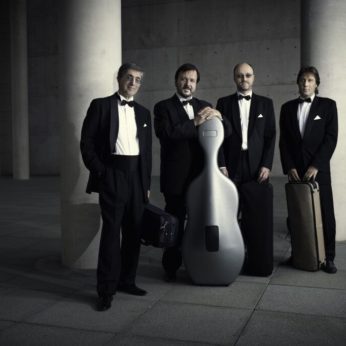Composer: Alexander Borodin (b. 1823 - d. 1887)
Performance date: 30/06/2015
Venue: Bantry Library
Composition Year: 1881
Duration: 00:29:30
Recording Engineer: Richard McCullough, RTÉ lyric fm
Instrumentation: 2vn, va, vc
Instrumentation Category:String Quartet
Artists:
Borodin String Quartet (Ruben Aharonian, Sergey Lamovsky [violins], Igor Naidin [viola], Vladimir Balshin [cello]) -
[quartet]

Alexander Borodin was a remarkable man. Always
interested in and talented at music, he spent most of his career as an academic
chemist. He became a Professor in
Petersburg
organic chemistry. Tall and good looking he spoke four European languages and
was an ardent advocate of women’s rights and education. In 1872 he helped found
the first University course in
for female doctors. He had a passionate
marriage to an eminent pianist, Ekatarina Protopopova. They had no children themselves
but adopted children in need. He also
composed some of the most glorious music of the second half of the nineteenth
century.
Borodin was one for the Mighty Handful of Russian composers who laid the foundations for
the later achievements of Russian music. Most of them composed little chamber
music but for Borodin it was a lifelong interest. He started to compose and
play chamber music at home while a teenager. He played the cello while his best
friend played the violin. They both played the piano.
The Second Quartet, composed in the summer of 1881,
was dedicated to his wife to celebrate twenty years of marriage. All four movements are in sonata form. The
first movement opens with the mellifluous main theme on the cello. The first
violin takes over and the two instruments pass the theme back and forth until
the violin introduces the more robust second subject. This is then played by
violin and cello together. All the instruments interplay a four note motif as
the opening comes to an animated conclusion.
The development begins again on the cello which is answered by the
violin. The viola also takes part in the
thematic development and finally the second violin as well. The music slows for
the start of the recapitulation. The movement
ends quietly with the viola repeating the four note motif.
The Scherzo
is built around a busy first subject where the first note of each bar is strongly
emphasised. The second theme is a glorious waltz-like tune played by both first
and second violins. The harmonies here (and in other parts of the quartet) mix lushness
with astringency. At times it almost sounds like Mahler.
The famous (and much copied) third movement is a
wonderful Nocturne. The sumptuous
opening tune is introduced by the cello with a throbbing second violin and
viola before being taken up by the violin. The second theme begins with an
upward scale followed by a descending sequence of trills. This is played by the
violins in turn. In the development the upward scale is used as an introduction
to the main theme which is now played by all four instruments After the viola
has had its turn, Borodin constructs a canon with the cello leading and the
first violin following a beat behind. He
repeats this idea with the first violin leading and the second violin again a
beat behind. The viola and cello provide a tremolo and pizzicato accompaniment
respectively. The effect is wonderfully passionate and romantic. It is hard not
to think of lovers lying entwined on a warm summer night (of which more below).
The Finale
begins with a brief slow introduction made up two different phrases. The first
is played by the violins; the second, a more serious motif, by the viola and
cello. The movement proper begins introduced by pizzicato cello and taken up by all the instruments in turn almost
like a train gathering speed. The slow
introduction returns at the beginning of the development, the viola and cello
playing the first vivace and the two
violins playing the second andante.
Finally the slow introduction returns for a final time played by all four
instruments in unison at the start of the recapitulation.
Russian critics have constructed a programme for
the whole quartet. They argue that the cello stands for Borodin and the first
violin for Protopopova. The first movement describes their meeting, the second
with its waltz like theme their courtship. Their passion is consummated in the
third movement and in the finale what? Normal life resumes perhaps.
It is true that in the first and third movements
the cello often introduces themes which are then taken up by the first violin. But this does not invariably happen and it
does not happen at the climax of the third movement If you are writing a quartet for your wife
on the occasion of your wedding anniversary, the inclusion of a passionate and
romantic slow movement seems quite natural. The marvel here is quite how
romantic and passionate the third movement actually is. The rest of the quartet
is abstract music. The whole quartet is beautifully constructed and is one of
the great pieces of chamber music of its time.
This quartet was the last major work Borodin
completed. After all he had plenty of other things to do. He died six years
later of a sudden heart attack at a ball in
complete an energetic waltz before dying almost immediately. Protopopova died
six months later. Although Borodin’s
scientific work is not entirely forgotten, his music and, especially this Second
Quartet, will continue to delight audiences for a very long time.
Copyright © 2025 West Cork Music. All rights reserved.
Designed and developed by Matrix Internet